MBA Project: Feasibility of Cashless Transactions in Malaysia
VerifiedAdded on 2022/12/27
|61
|14375
|79
Project
AI Summary
This MBA project undertakes a comprehensive feasibility study on the adoption of cashless transactions in Malaysia. The study begins with an introduction outlining the importance of financial inclusion and the benefits of electronic payments for economic growth and competitiveness. It then presents a literature review that explores technological innovation, technological readiness, and the adoption of e-payment systems. The project analyzes the challenges and opportunities within the Malaysian digital payment ecosystem, including stakeholder analysis (consumers, businesses, and service providers). The research objectives include identifying factors influencing e-payment adoption, diagnosing reasons for non-acceptance, and uncovering the interconnections between these factors to provide recommendations for future development. The project investigates the factors influencing e-payment adoption by stakeholders, the challenges faced by technology service providers, and the implications of cashless payment adoption. The conclusion summarizes the key findings, discusses the research limitations, and suggests areas for future research. The project also includes a chapter on data analysis to support the conclusions.
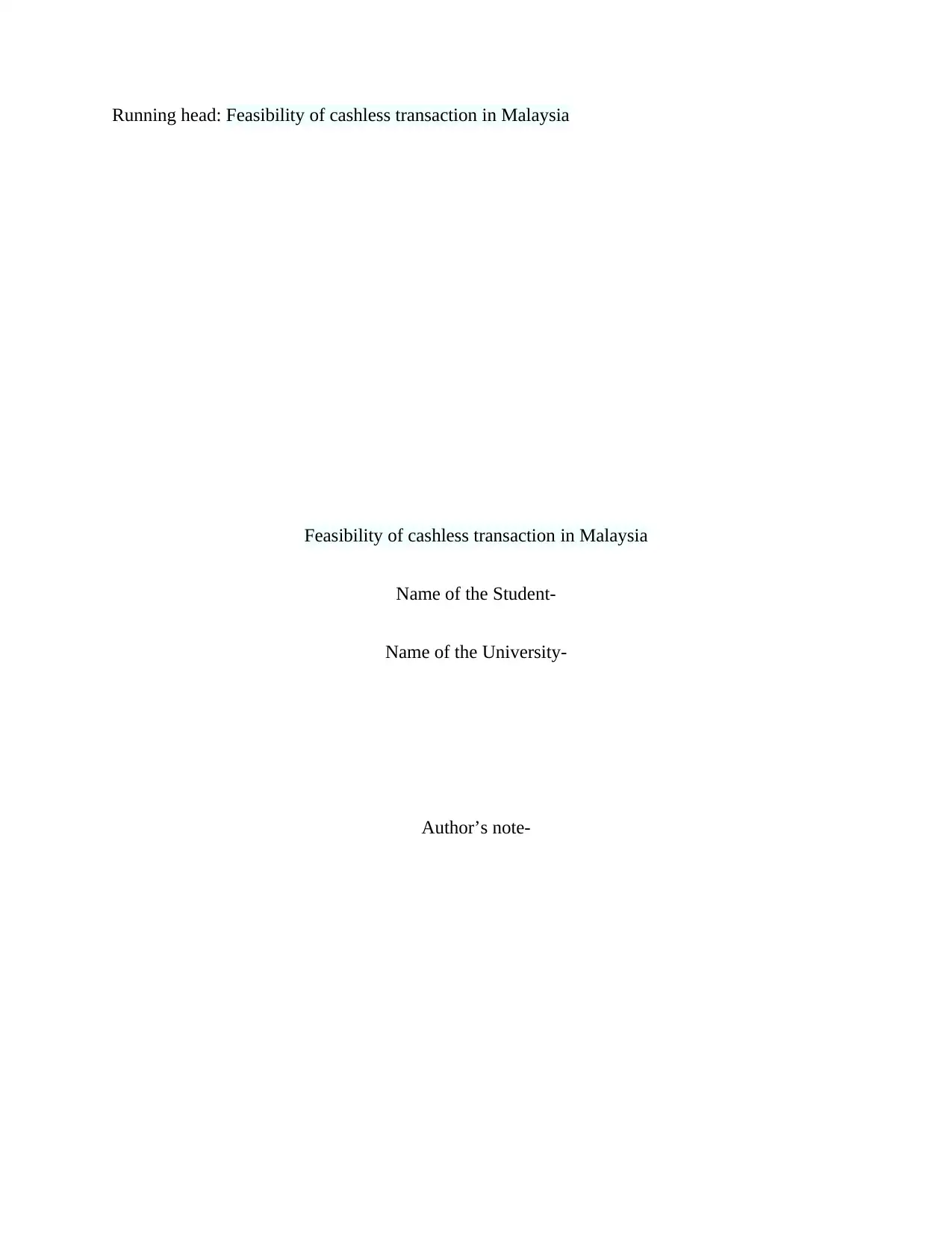
Running head: Feasibility of cashless transaction in Malaysia
Feasibility of cashless transaction in Malaysia
Name of the Student-
Name of the University-
Author’s note-
Feasibility of cashless transaction in Malaysia
Name of the Student-
Name of the University-
Author’s note-
Paraphrase This Document
Need a fresh take? Get an instant paraphrase of this document with our AI Paraphraser
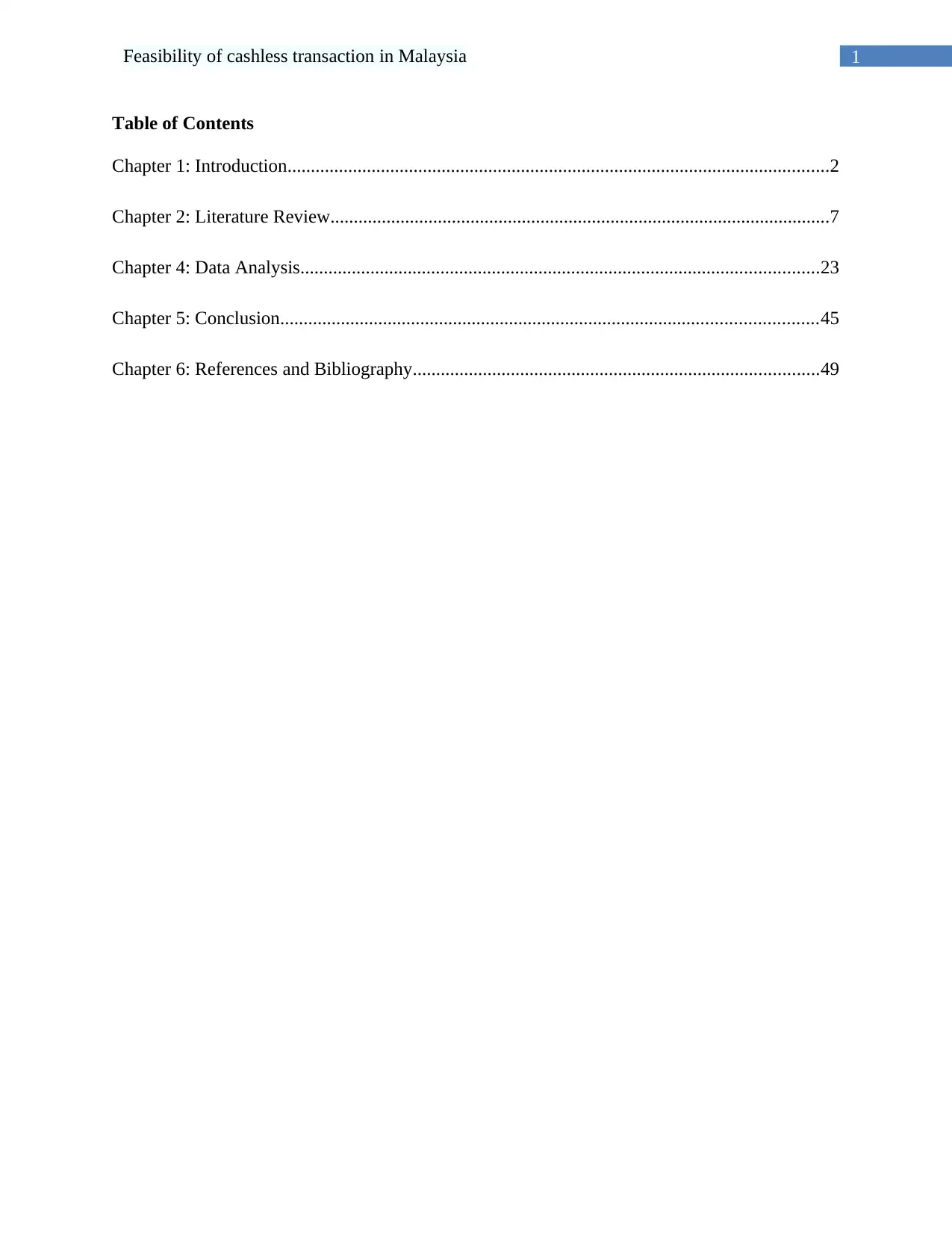
1Feasibility of cashless transaction in Malaysia
Table of Contents
Chapter 1: Introduction....................................................................................................................2
Chapter 2: Literature Review...........................................................................................................7
Chapter 4: Data Analysis...............................................................................................................23
Chapter 5: Conclusion...................................................................................................................45
Chapter 6: References and Bibliography.......................................................................................49
Table of Contents
Chapter 1: Introduction....................................................................................................................2
Chapter 2: Literature Review...........................................................................................................7
Chapter 4: Data Analysis...............................................................................................................23
Chapter 5: Conclusion...................................................................................................................45
Chapter 6: References and Bibliography.......................................................................................49
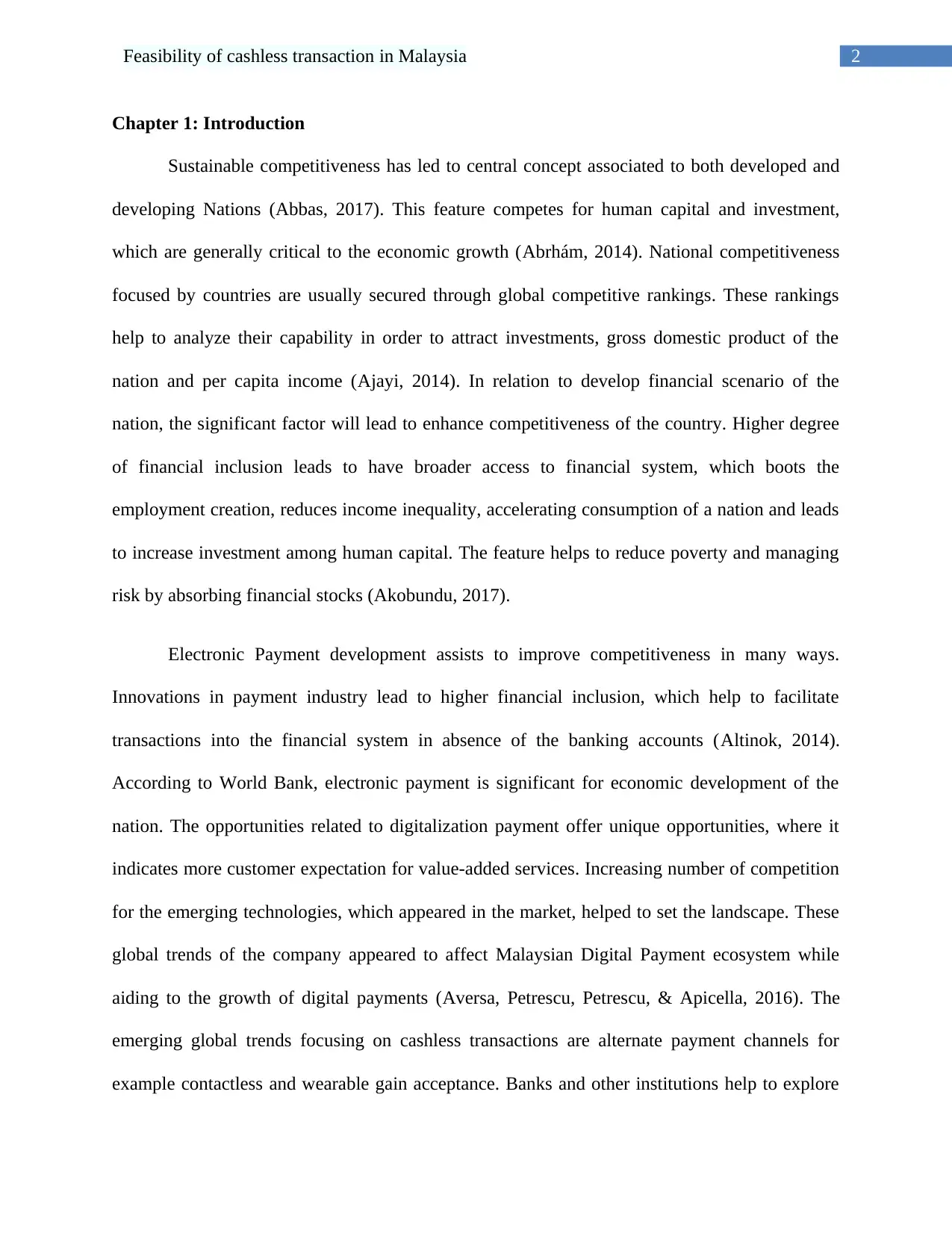
2Feasibility of cashless transaction in Malaysia
Chapter 1: Introduction
Sustainable competitiveness has led to central concept associated to both developed and
developing Nations (Abbas, 2017). This feature competes for human capital and investment,
which are generally critical to the economic growth (Abrhám, 2014). National competitiveness
focused by countries are usually secured through global competitive rankings. These rankings
help to analyze their capability in order to attract investments, gross domestic product of the
nation and per capita income (Ajayi, 2014). In relation to develop financial scenario of the
nation, the significant factor will lead to enhance competitiveness of the country. Higher degree
of financial inclusion leads to have broader access to financial system, which boots the
employment creation, reduces income inequality, accelerating consumption of a nation and leads
to increase investment among human capital. The feature helps to reduce poverty and managing
risk by absorbing financial stocks (Akobundu, 2017).
Electronic Payment development assists to improve competitiveness in many ways.
Innovations in payment industry lead to higher financial inclusion, which help to facilitate
transactions into the financial system in absence of the banking accounts (Altinok, 2014).
According to World Bank, electronic payment is significant for economic development of the
nation. The opportunities related to digitalization payment offer unique opportunities, where it
indicates more customer expectation for value-added services. Increasing number of competition
for the emerging technologies, which appeared in the market, helped to set the landscape. These
global trends of the company appeared to affect Malaysian Digital Payment ecosystem while
aiding to the growth of digital payments (Aversa, Petrescu, Petrescu, & Apicella, 2016). The
emerging global trends focusing on cashless transactions are alternate payment channels for
example contactless and wearable gain acceptance. Banks and other institutions help to explore
Chapter 1: Introduction
Sustainable competitiveness has led to central concept associated to both developed and
developing Nations (Abbas, 2017). This feature competes for human capital and investment,
which are generally critical to the economic growth (Abrhám, 2014). National competitiveness
focused by countries are usually secured through global competitive rankings. These rankings
help to analyze their capability in order to attract investments, gross domestic product of the
nation and per capita income (Ajayi, 2014). In relation to develop financial scenario of the
nation, the significant factor will lead to enhance competitiveness of the country. Higher degree
of financial inclusion leads to have broader access to financial system, which boots the
employment creation, reduces income inequality, accelerating consumption of a nation and leads
to increase investment among human capital. The feature helps to reduce poverty and managing
risk by absorbing financial stocks (Akobundu, 2017).
Electronic Payment development assists to improve competitiveness in many ways.
Innovations in payment industry lead to higher financial inclusion, which help to facilitate
transactions into the financial system in absence of the banking accounts (Altinok, 2014).
According to World Bank, electronic payment is significant for economic development of the
nation. The opportunities related to digitalization payment offer unique opportunities, where it
indicates more customer expectation for value-added services. Increasing number of competition
for the emerging technologies, which appeared in the market, helped to set the landscape. These
global trends of the company appeared to affect Malaysian Digital Payment ecosystem while
aiding to the growth of digital payments (Aversa, Petrescu, Petrescu, & Apicella, 2016). The
emerging global trends focusing on cashless transactions are alternate payment channels for
example contactless and wearable gain acceptance. Banks and other institutions help to explore
⊘ This is a preview!⊘
Do you want full access?
Subscribe today to unlock all pages.

Trusted by 1+ million students worldwide
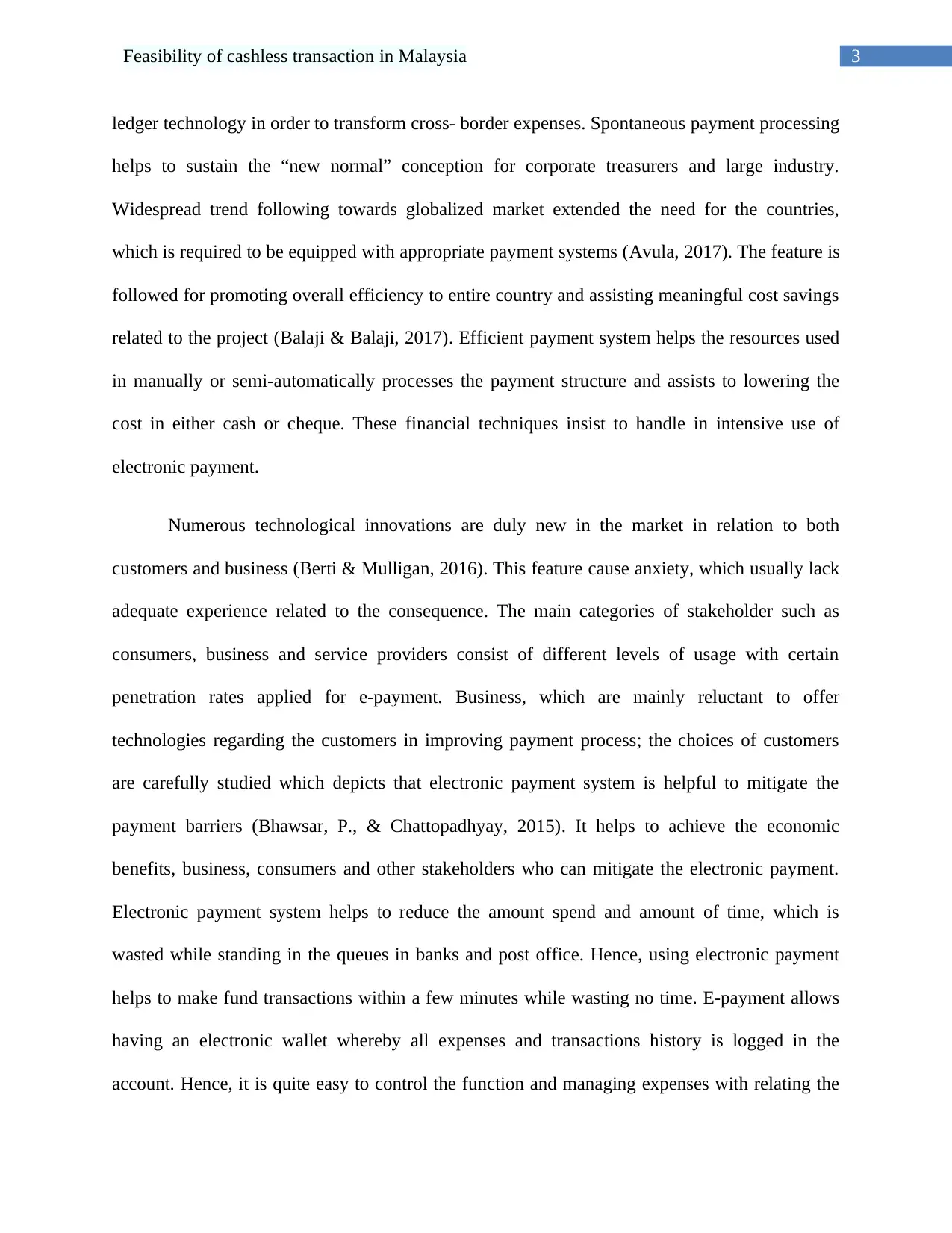
3Feasibility of cashless transaction in Malaysia
ledger technology in order to transform cross- border expenses. Spontaneous payment processing
helps to sustain the “new normal” conception for corporate treasurers and large industry.
Widespread trend following towards globalized market extended the need for the countries,
which is required to be equipped with appropriate payment systems (Avula, 2017). The feature is
followed for promoting overall efficiency to entire country and assisting meaningful cost savings
related to the project (Balaji & Balaji, 2017). Efficient payment system helps the resources used
in manually or semi-automatically processes the payment structure and assists to lowering the
cost in either cash or cheque. These financial techniques insist to handle in intensive use of
electronic payment.
Numerous technological innovations are duly new in the market in relation to both
customers and business (Berti & Mulligan, 2016). This feature cause anxiety, which usually lack
adequate experience related to the consequence. The main categories of stakeholder such as
consumers, business and service providers consist of different levels of usage with certain
penetration rates applied for e-payment. Business, which are mainly reluctant to offer
technologies regarding the customers in improving payment process; the choices of customers
are carefully studied which depicts that electronic payment system is helpful to mitigate the
payment barriers (Bhawsar, P., & Chattopadhyay, 2015). It helps to achieve the economic
benefits, business, consumers and other stakeholders who can mitigate the electronic payment.
Electronic payment system helps to reduce the amount spend and amount of time, which is
wasted while standing in the queues in banks and post office. Hence, using electronic payment
helps to make fund transactions within a few minutes while wasting no time. E-payment allows
having an electronic wallet whereby all expenses and transactions history is logged in the
account. Hence, it is quite easy to control the function and managing expenses with relating the
ledger technology in order to transform cross- border expenses. Spontaneous payment processing
helps to sustain the “new normal” conception for corporate treasurers and large industry.
Widespread trend following towards globalized market extended the need for the countries,
which is required to be equipped with appropriate payment systems (Avula, 2017). The feature is
followed for promoting overall efficiency to entire country and assisting meaningful cost savings
related to the project (Balaji & Balaji, 2017). Efficient payment system helps the resources used
in manually or semi-automatically processes the payment structure and assists to lowering the
cost in either cash or cheque. These financial techniques insist to handle in intensive use of
electronic payment.
Numerous technological innovations are duly new in the market in relation to both
customers and business (Berti & Mulligan, 2016). This feature cause anxiety, which usually lack
adequate experience related to the consequence. The main categories of stakeholder such as
consumers, business and service providers consist of different levels of usage with certain
penetration rates applied for e-payment. Business, which are mainly reluctant to offer
technologies regarding the customers in improving payment process; the choices of customers
are carefully studied which depicts that electronic payment system is helpful to mitigate the
payment barriers (Bhawsar, P., & Chattopadhyay, 2015). It helps to achieve the economic
benefits, business, consumers and other stakeholders who can mitigate the electronic payment.
Electronic payment system helps to reduce the amount spend and amount of time, which is
wasted while standing in the queues in banks and post office. Hence, using electronic payment
helps to make fund transactions within a few minutes while wasting no time. E-payment allows
having an electronic wallet whereby all expenses and transactions history is logged in the
account. Hence, it is quite easy to control the function and managing expenses with relating the
Paraphrase This Document
Need a fresh take? Get an instant paraphrase of this document with our AI Paraphraser
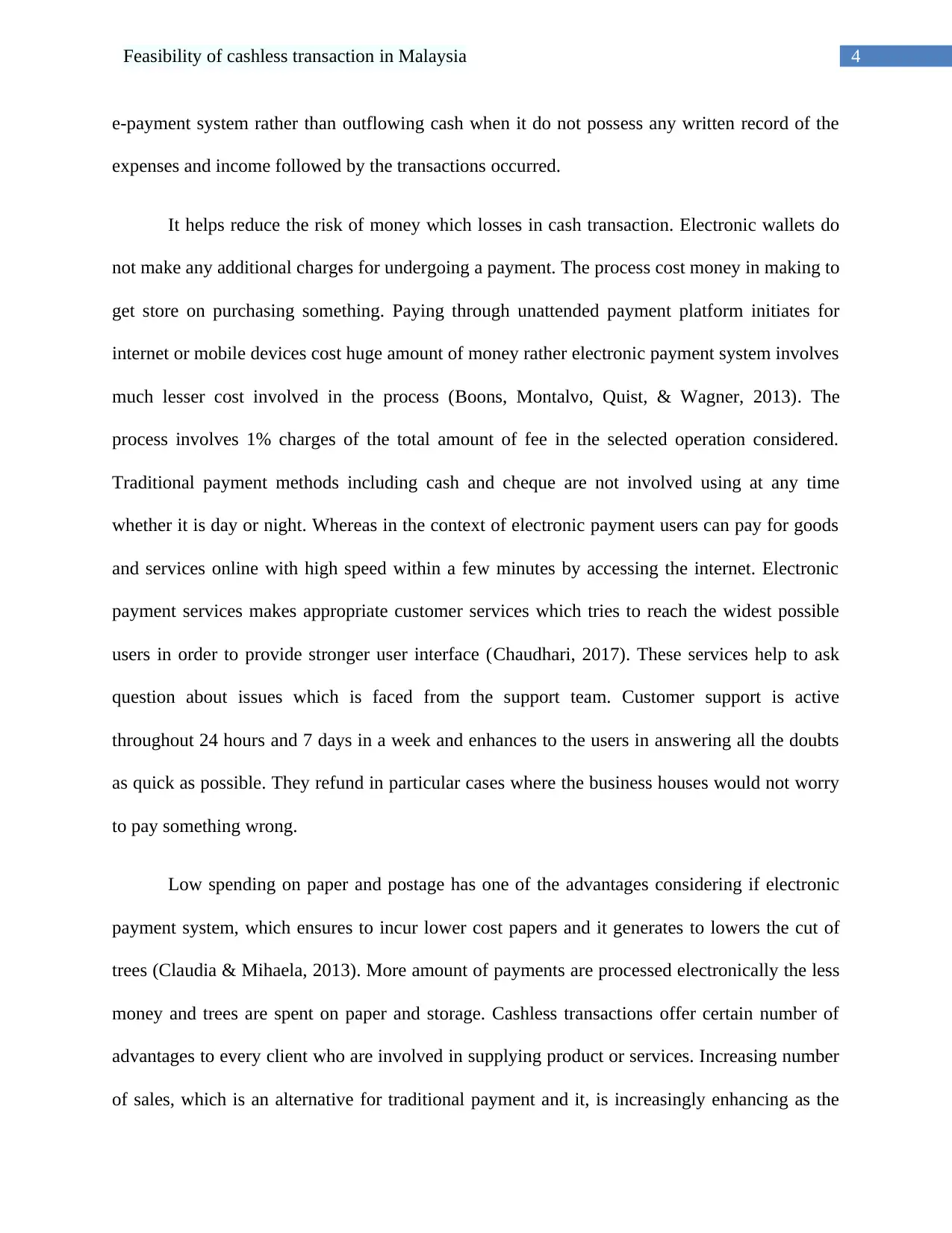
4Feasibility of cashless transaction in Malaysia
e-payment system rather than outflowing cash when it do not possess any written record of the
expenses and income followed by the transactions occurred.
It helps reduce the risk of money which losses in cash transaction. Electronic wallets do
not make any additional charges for undergoing a payment. The process cost money in making to
get store on purchasing something. Paying through unattended payment platform initiates for
internet or mobile devices cost huge amount of money rather electronic payment system involves
much lesser cost involved in the process (Boons, Montalvo, Quist, & Wagner, 2013). The
process involves 1% charges of the total amount of fee in the selected operation considered.
Traditional payment methods including cash and cheque are not involved using at any time
whether it is day or night. Whereas in the context of electronic payment users can pay for goods
and services online with high speed within a few minutes by accessing the internet. Electronic
payment services makes appropriate customer services which tries to reach the widest possible
users in order to provide stronger user interface (Chaudhari, 2017). These services help to ask
question about issues which is faced from the support team. Customer support is active
throughout 24 hours and 7 days in a week and enhances to the users in answering all the doubts
as quick as possible. They refund in particular cases where the business houses would not worry
to pay something wrong.
Low spending on paper and postage has one of the advantages considering if electronic
payment system, which ensures to incur lower cost papers and it generates to lowers the cut of
trees (Claudia & Mihaela, 2013). More amount of payments are processed electronically the less
money and trees are spent on paper and storage. Cashless transactions offer certain number of
advantages to every client who are involved in supplying product or services. Increasing number
of sales, which is an alternative for traditional payment and it, is increasingly enhancing as the
e-payment system rather than outflowing cash when it do not possess any written record of the
expenses and income followed by the transactions occurred.
It helps reduce the risk of money which losses in cash transaction. Electronic wallets do
not make any additional charges for undergoing a payment. The process cost money in making to
get store on purchasing something. Paying through unattended payment platform initiates for
internet or mobile devices cost huge amount of money rather electronic payment system involves
much lesser cost involved in the process (Boons, Montalvo, Quist, & Wagner, 2013). The
process involves 1% charges of the total amount of fee in the selected operation considered.
Traditional payment methods including cash and cheque are not involved using at any time
whether it is day or night. Whereas in the context of electronic payment users can pay for goods
and services online with high speed within a few minutes by accessing the internet. Electronic
payment services makes appropriate customer services which tries to reach the widest possible
users in order to provide stronger user interface (Chaudhari, 2017). These services help to ask
question about issues which is faced from the support team. Customer support is active
throughout 24 hours and 7 days in a week and enhances to the users in answering all the doubts
as quick as possible. They refund in particular cases where the business houses would not worry
to pay something wrong.
Low spending on paper and postage has one of the advantages considering if electronic
payment system, which ensures to incur lower cost papers and it generates to lowers the cut of
trees (Claudia & Mihaela, 2013). More amount of payments are processed electronically the less
money and trees are spent on paper and storage. Cashless transactions offer certain number of
advantages to every client who are involved in supplying product or services. Increasing number
of sales, which is an alternative for traditional payment and it, is increasingly enhancing as the
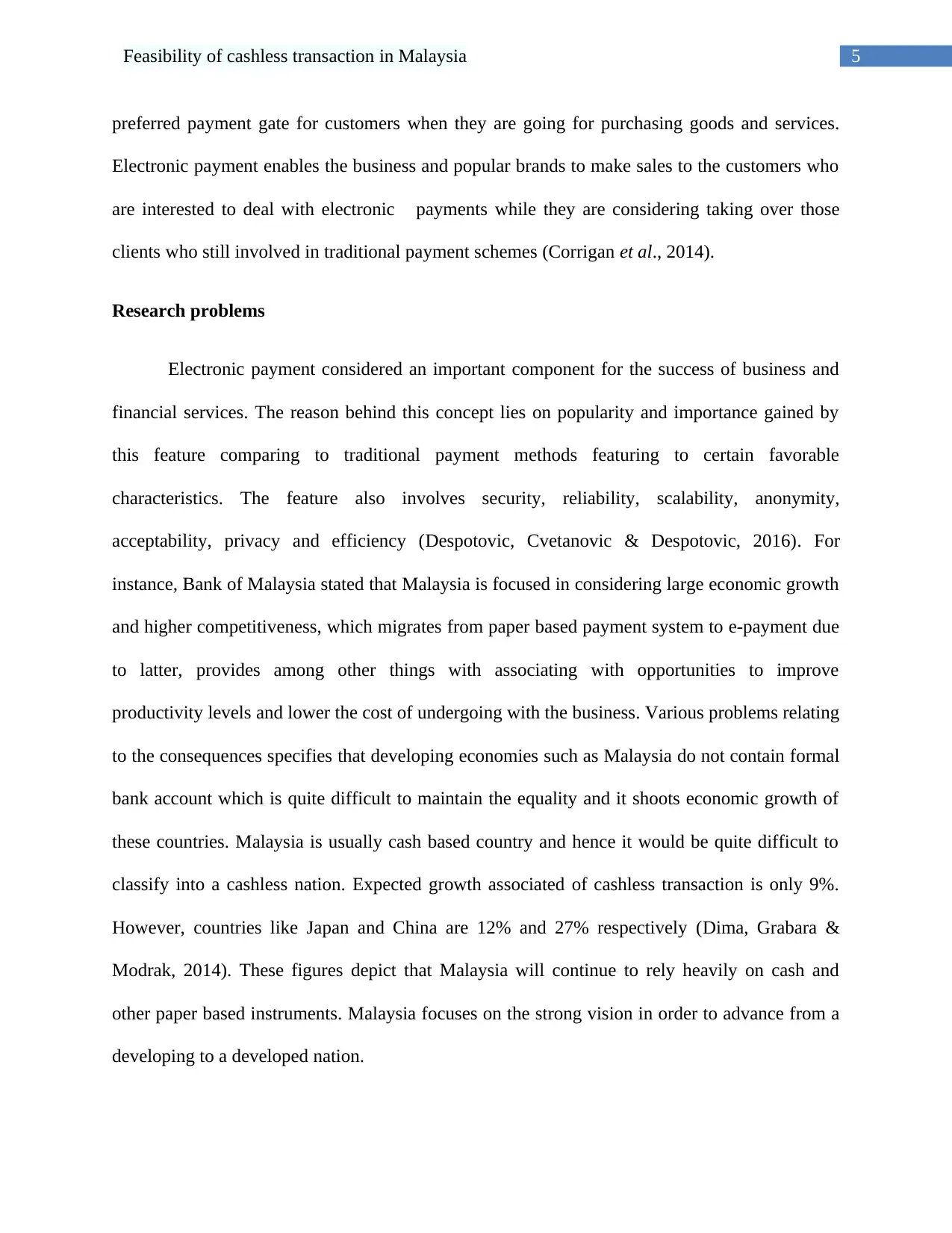
5Feasibility of cashless transaction in Malaysia
preferred payment gate for customers when they are going for purchasing goods and services.
Electronic payment enables the business and popular brands to make sales to the customers who
are interested to deal with electronic payments while they are considering taking over those
clients who still involved in traditional payment schemes (Corrigan et al., 2014).
Research problems
Electronic payment considered an important component for the success of business and
financial services. The reason behind this concept lies on popularity and importance gained by
this feature comparing to traditional payment methods featuring to certain favorable
characteristics. The feature also involves security, reliability, scalability, anonymity,
acceptability, privacy and efficiency (Despotovic, Cvetanovic & Despotovic, 2016). For
instance, Bank of Malaysia stated that Malaysia is focused in considering large economic growth
and higher competitiveness, which migrates from paper based payment system to e-payment due
to latter, provides among other things with associating with opportunities to improve
productivity levels and lower the cost of undergoing with the business. Various problems relating
to the consequences specifies that developing economies such as Malaysia do not contain formal
bank account which is quite difficult to maintain the equality and it shoots economic growth of
these countries. Malaysia is usually cash based country and hence it would be quite difficult to
classify into a cashless nation. Expected growth associated of cashless transaction is only 9%.
However, countries like Japan and China are 12% and 27% respectively (Dima, Grabara &
Modrak, 2014). These figures depict that Malaysia will continue to rely heavily on cash and
other paper based instruments. Malaysia focuses on the strong vision in order to advance from a
developing to a developed nation.
preferred payment gate for customers when they are going for purchasing goods and services.
Electronic payment enables the business and popular brands to make sales to the customers who
are interested to deal with electronic payments while they are considering taking over those
clients who still involved in traditional payment schemes (Corrigan et al., 2014).
Research problems
Electronic payment considered an important component for the success of business and
financial services. The reason behind this concept lies on popularity and importance gained by
this feature comparing to traditional payment methods featuring to certain favorable
characteristics. The feature also involves security, reliability, scalability, anonymity,
acceptability, privacy and efficiency (Despotovic, Cvetanovic & Despotovic, 2016). For
instance, Bank of Malaysia stated that Malaysia is focused in considering large economic growth
and higher competitiveness, which migrates from paper based payment system to e-payment due
to latter, provides among other things with associating with opportunities to improve
productivity levels and lower the cost of undergoing with the business. Various problems relating
to the consequences specifies that developing economies such as Malaysia do not contain formal
bank account which is quite difficult to maintain the equality and it shoots economic growth of
these countries. Malaysia is usually cash based country and hence it would be quite difficult to
classify into a cashless nation. Expected growth associated of cashless transaction is only 9%.
However, countries like Japan and China are 12% and 27% respectively (Dima, Grabara &
Modrak, 2014). These figures depict that Malaysia will continue to rely heavily on cash and
other paper based instruments. Malaysia focuses on the strong vision in order to advance from a
developing to a developed nation.
⊘ This is a preview!⊘
Do you want full access?
Subscribe today to unlock all pages.

Trusted by 1+ million students worldwide
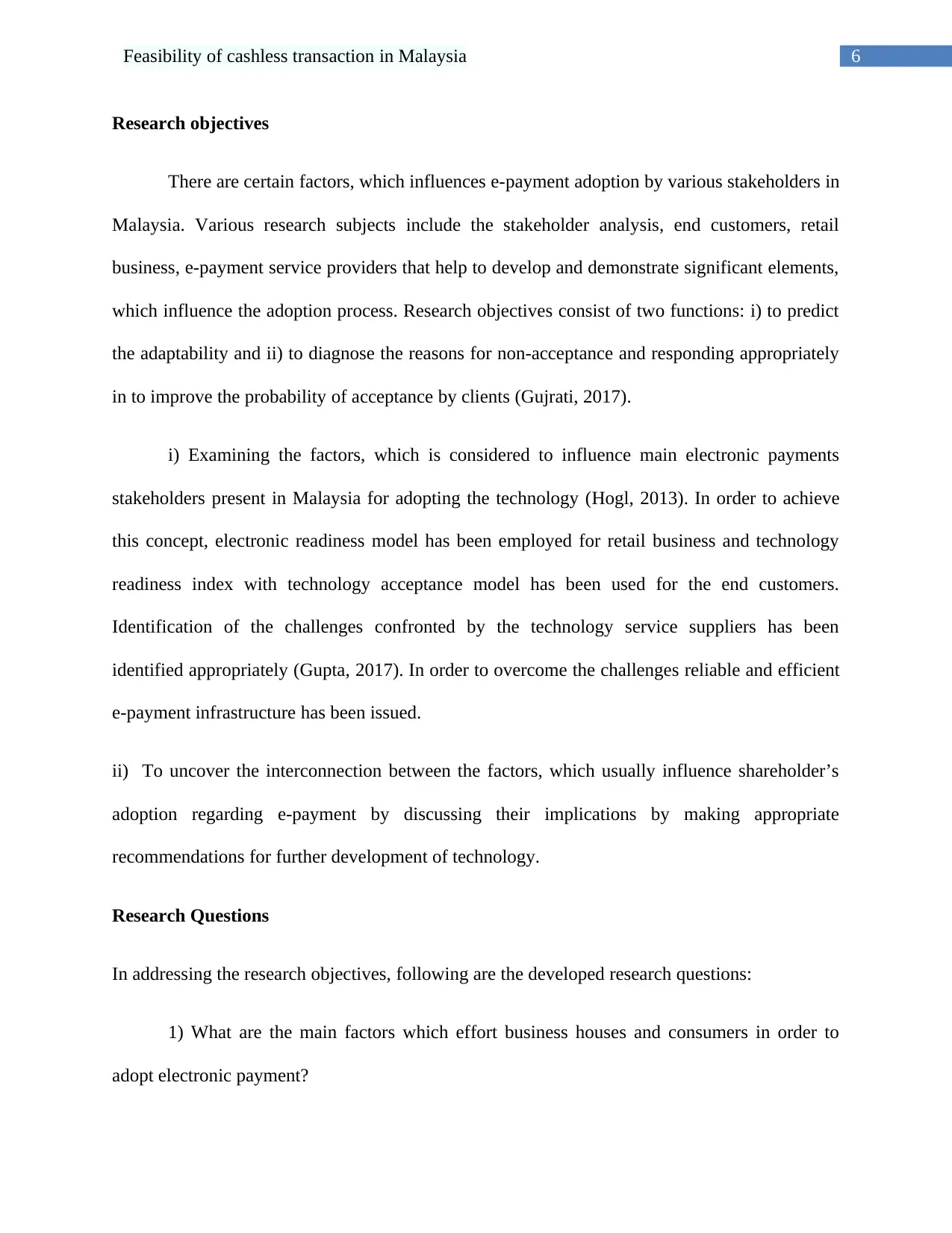
6Feasibility of cashless transaction in Malaysia
Research objectives
There are certain factors, which influences e-payment adoption by various stakeholders in
Malaysia. Various research subjects include the stakeholder analysis, end customers, retail
business, e-payment service providers that help to develop and demonstrate significant elements,
which influence the adoption process. Research objectives consist of two functions: i) to predict
the adaptability and ii) to diagnose the reasons for non-acceptance and responding appropriately
in to improve the probability of acceptance by clients (Gujrati, 2017).
i) Examining the factors, which is considered to influence main electronic payments
stakeholders present in Malaysia for adopting the technology (Hogl, 2013). In order to achieve
this concept, electronic readiness model has been employed for retail business and technology
readiness index with technology acceptance model has been used for the end customers.
Identification of the challenges confronted by the technology service suppliers has been
identified appropriately (Gupta, 2017). In order to overcome the challenges reliable and efficient
e-payment infrastructure has been issued.
ii) To uncover the interconnection between the factors, which usually influence shareholder’s
adoption regarding e-payment by discussing their implications by making appropriate
recommendations for further development of technology.
Research Questions
In addressing the research objectives, following are the developed research questions:
1) What are the main factors which effort business houses and consumers in order to
adopt electronic payment?
Research objectives
There are certain factors, which influences e-payment adoption by various stakeholders in
Malaysia. Various research subjects include the stakeholder analysis, end customers, retail
business, e-payment service providers that help to develop and demonstrate significant elements,
which influence the adoption process. Research objectives consist of two functions: i) to predict
the adaptability and ii) to diagnose the reasons for non-acceptance and responding appropriately
in to improve the probability of acceptance by clients (Gujrati, 2017).
i) Examining the factors, which is considered to influence main electronic payments
stakeholders present in Malaysia for adopting the technology (Hogl, 2013). In order to achieve
this concept, electronic readiness model has been employed for retail business and technology
readiness index with technology acceptance model has been used for the end customers.
Identification of the challenges confronted by the technology service suppliers has been
identified appropriately (Gupta, 2017). In order to overcome the challenges reliable and efficient
e-payment infrastructure has been issued.
ii) To uncover the interconnection between the factors, which usually influence shareholder’s
adoption regarding e-payment by discussing their implications by making appropriate
recommendations for further development of technology.
Research Questions
In addressing the research objectives, following are the developed research questions:
1) What are the main factors which effort business houses and consumers in order to
adopt electronic payment?
Paraphrase This Document
Need a fresh take? Get an instant paraphrase of this document with our AI Paraphraser
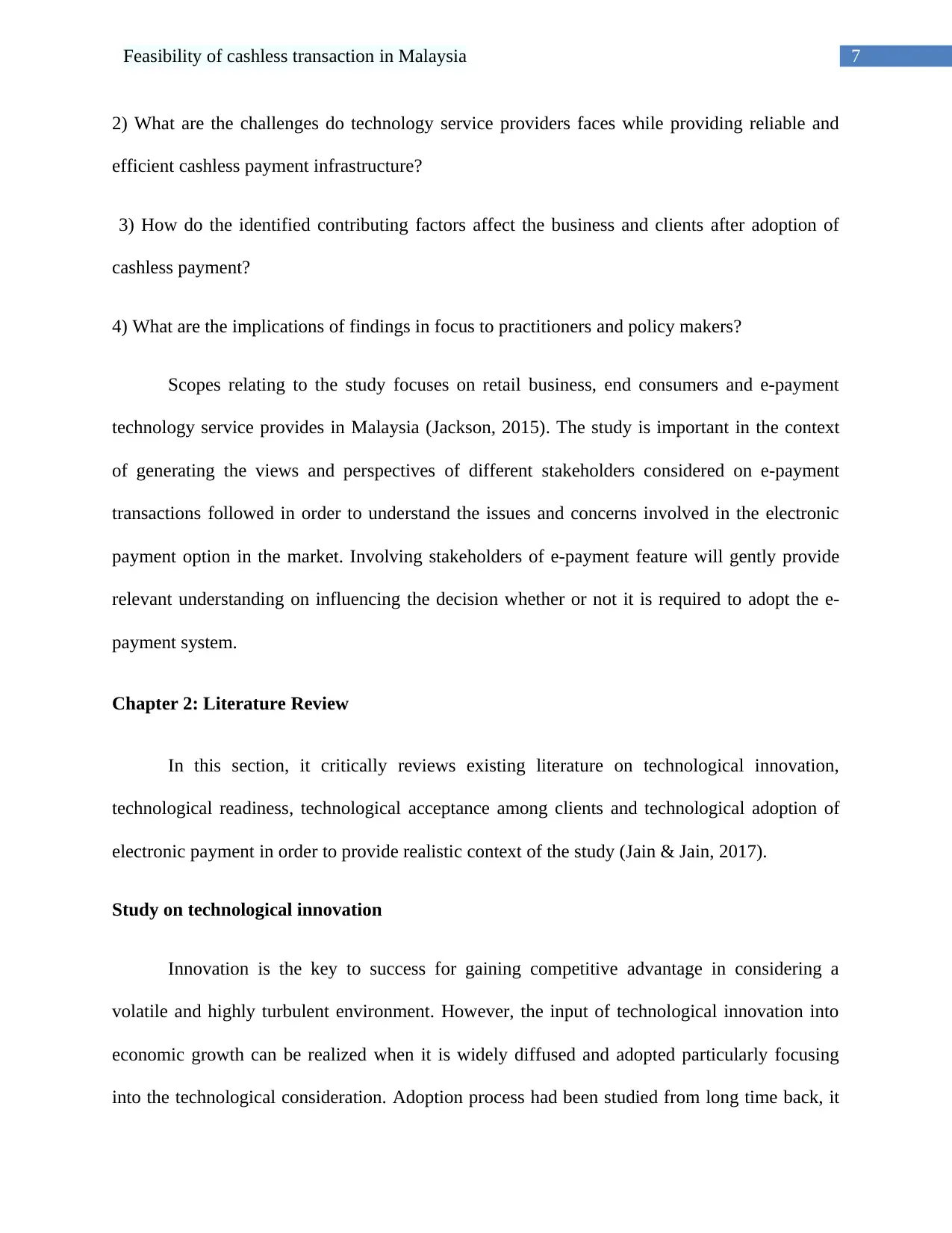
7Feasibility of cashless transaction in Malaysia
2) What are the challenges do technology service providers faces while providing reliable and
efficient cashless payment infrastructure?
3) How do the identified contributing factors affect the business and clients after adoption of
cashless payment?
4) What are the implications of findings in focus to practitioners and policy makers?
Scopes relating to the study focuses on retail business, end consumers and e-payment
technology service provides in Malaysia (Jackson, 2015). The study is important in the context
of generating the views and perspectives of different stakeholders considered on e-payment
transactions followed in order to understand the issues and concerns involved in the electronic
payment option in the market. Involving stakeholders of e-payment feature will gently provide
relevant understanding on influencing the decision whether or not it is required to adopt the e-
payment system.
Chapter 2: Literature Review
In this section, it critically reviews existing literature on technological innovation,
technological readiness, technological acceptance among clients and technological adoption of
electronic payment in order to provide realistic context of the study (Jain & Jain, 2017).
Study on technological innovation
Innovation is the key to success for gaining competitive advantage in considering a
volatile and highly turbulent environment. However, the input of technological innovation into
economic growth can be realized when it is widely diffused and adopted particularly focusing
into the technological consideration. Adoption process had been studied from long time back, it
2) What are the challenges do technology service providers faces while providing reliable and
efficient cashless payment infrastructure?
3) How do the identified contributing factors affect the business and clients after adoption of
cashless payment?
4) What are the implications of findings in focus to practitioners and policy makers?
Scopes relating to the study focuses on retail business, end consumers and e-payment
technology service provides in Malaysia (Jackson, 2015). The study is important in the context
of generating the views and perspectives of different stakeholders considered on e-payment
transactions followed in order to understand the issues and concerns involved in the electronic
payment option in the market. Involving stakeholders of e-payment feature will gently provide
relevant understanding on influencing the decision whether or not it is required to adopt the e-
payment system.
Chapter 2: Literature Review
In this section, it critically reviews existing literature on technological innovation,
technological readiness, technological acceptance among clients and technological adoption of
electronic payment in order to provide realistic context of the study (Jain & Jain, 2017).
Study on technological innovation
Innovation is the key to success for gaining competitive advantage in considering a
volatile and highly turbulent environment. However, the input of technological innovation into
economic growth can be realized when it is widely diffused and adopted particularly focusing
into the technological consideration. Adoption process had been studied from long time back, it
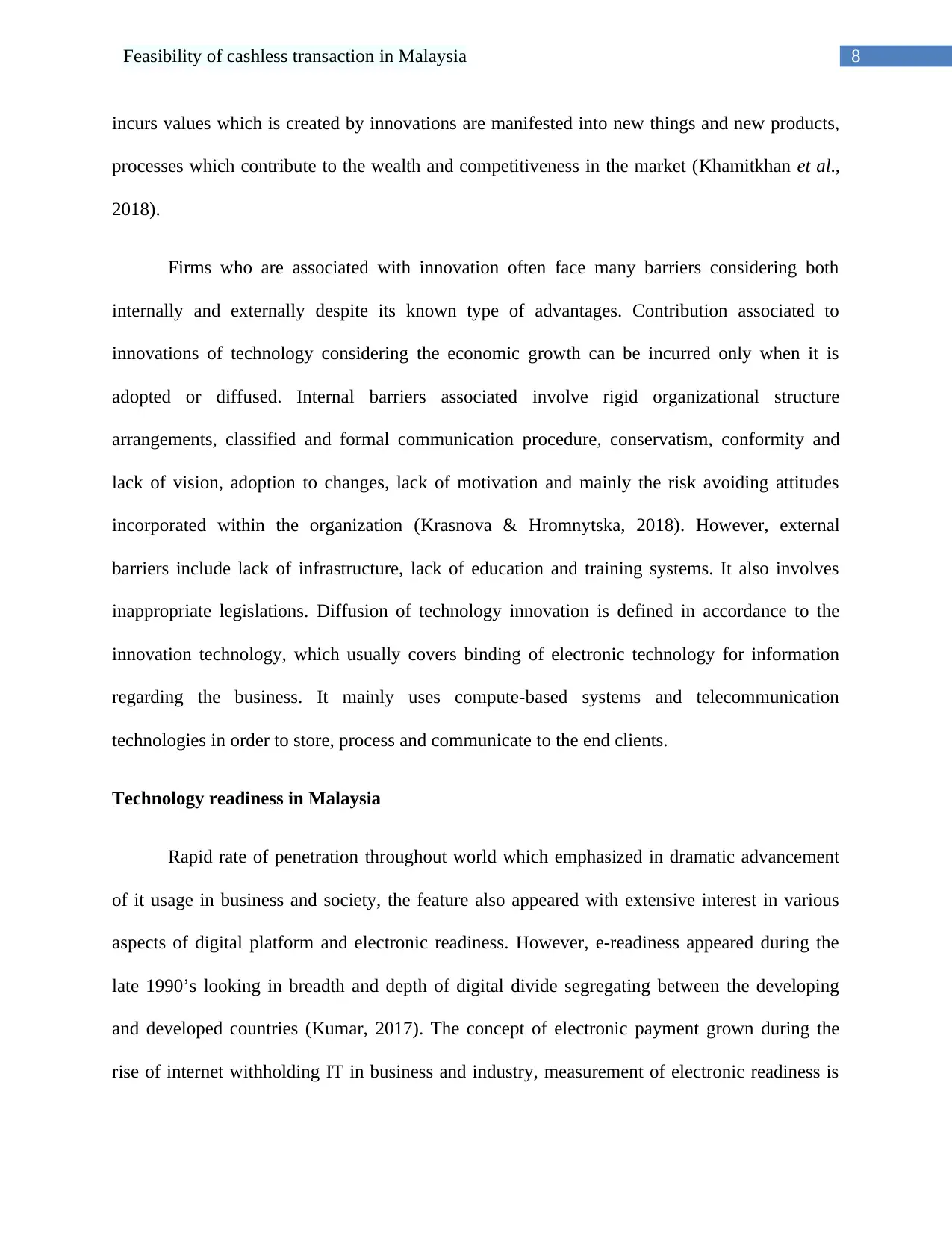
8Feasibility of cashless transaction in Malaysia
incurs values which is created by innovations are manifested into new things and new products,
processes which contribute to the wealth and competitiveness in the market (Khamitkhan et al.,
2018).
Firms who are associated with innovation often face many barriers considering both
internally and externally despite its known type of advantages. Contribution associated to
innovations of technology considering the economic growth can be incurred only when it is
adopted or diffused. Internal barriers associated involve rigid organizational structure
arrangements, classified and formal communication procedure, conservatism, conformity and
lack of vision, adoption to changes, lack of motivation and mainly the risk avoiding attitudes
incorporated within the organization (Krasnovа & Hromnytska, 2018). However, external
barriers include lack of infrastructure, lack of education and training systems. It also involves
inappropriate legislations. Diffusion of technology innovation is defined in accordance to the
innovation technology, which usually covers binding of electronic technology for information
regarding the business. It mainly uses compute-based systems and telecommunication
technologies in order to store, process and communicate to the end clients.
Technology readiness in Malaysia
Rapid rate of penetration throughout world which emphasized in dramatic advancement
of it usage in business and society, the feature also appeared with extensive interest in various
aspects of digital platform and electronic readiness. However, e-readiness appeared during the
late 1990’s looking in breadth and depth of digital divide segregating between the developing
and developed countries (Kumar, 2017). The concept of electronic payment grown during the
rise of internet withholding IT in business and industry, measurement of electronic readiness is
incurs values which is created by innovations are manifested into new things and new products,
processes which contribute to the wealth and competitiveness in the market (Khamitkhan et al.,
2018).
Firms who are associated with innovation often face many barriers considering both
internally and externally despite its known type of advantages. Contribution associated to
innovations of technology considering the economic growth can be incurred only when it is
adopted or diffused. Internal barriers associated involve rigid organizational structure
arrangements, classified and formal communication procedure, conservatism, conformity and
lack of vision, adoption to changes, lack of motivation and mainly the risk avoiding attitudes
incorporated within the organization (Krasnovа & Hromnytska, 2018). However, external
barriers include lack of infrastructure, lack of education and training systems. It also involves
inappropriate legislations. Diffusion of technology innovation is defined in accordance to the
innovation technology, which usually covers binding of electronic technology for information
regarding the business. It mainly uses compute-based systems and telecommunication
technologies in order to store, process and communicate to the end clients.
Technology readiness in Malaysia
Rapid rate of penetration throughout world which emphasized in dramatic advancement
of it usage in business and society, the feature also appeared with extensive interest in various
aspects of digital platform and electronic readiness. However, e-readiness appeared during the
late 1990’s looking in breadth and depth of digital divide segregating between the developing
and developed countries (Kumar, 2017). The concept of electronic payment grown during the
rise of internet withholding IT in business and industry, measurement of electronic readiness is
⊘ This is a preview!⊘
Do you want full access?
Subscribe today to unlock all pages.

Trusted by 1+ million students worldwide
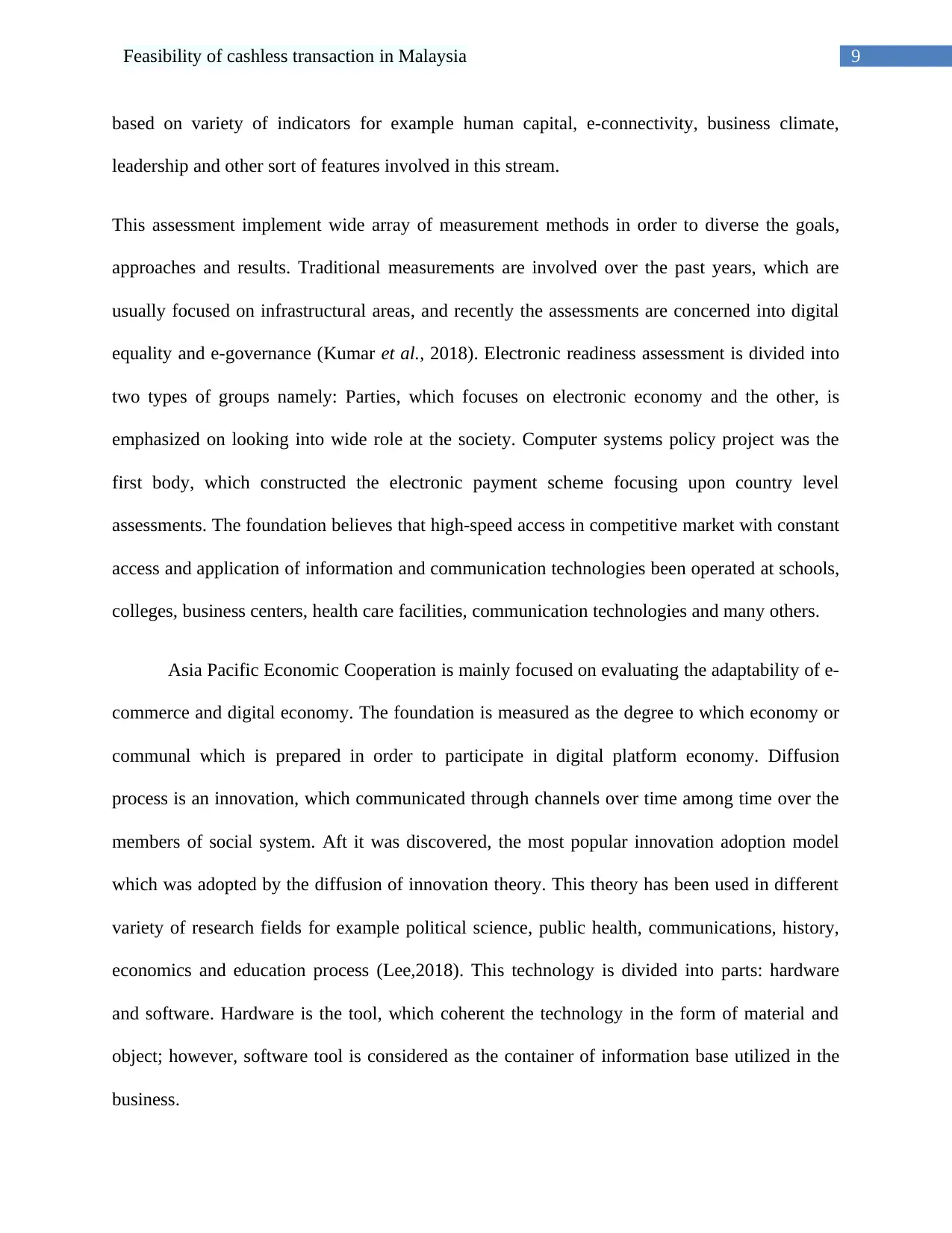
9Feasibility of cashless transaction in Malaysia
based on variety of indicators for example human capital, e-connectivity, business climate,
leadership and other sort of features involved in this stream.
This assessment implement wide array of measurement methods in order to diverse the goals,
approaches and results. Traditional measurements are involved over the past years, which are
usually focused on infrastructural areas, and recently the assessments are concerned into digital
equality and e-governance (Kumar et al., 2018). Electronic readiness assessment is divided into
two types of groups namely: Parties, which focuses on electronic economy and the other, is
emphasized on looking into wide role at the society. Computer systems policy project was the
first body, which constructed the electronic payment scheme focusing upon country level
assessments. The foundation believes that high-speed access in competitive market with constant
access and application of information and communication technologies been operated at schools,
colleges, business centers, health care facilities, communication technologies and many others.
Asia Pacific Economic Cooperation is mainly focused on evaluating the adaptability of e-
commerce and digital economy. The foundation is measured as the degree to which economy or
communal which is prepared in order to participate in digital platform economy. Diffusion
process is an innovation, which communicated through channels over time among time over the
members of social system. Aft it was discovered, the most popular innovation adoption model
which was adopted by the diffusion of innovation theory. This theory has been used in different
variety of research fields for example political science, public health, communications, history,
economics and education process (Lee,2018). This technology is divided into parts: hardware
and software. Hardware is the tool, which coherent the technology in the form of material and
object; however, software tool is considered as the container of information base utilized in the
business.
based on variety of indicators for example human capital, e-connectivity, business climate,
leadership and other sort of features involved in this stream.
This assessment implement wide array of measurement methods in order to diverse the goals,
approaches and results. Traditional measurements are involved over the past years, which are
usually focused on infrastructural areas, and recently the assessments are concerned into digital
equality and e-governance (Kumar et al., 2018). Electronic readiness assessment is divided into
two types of groups namely: Parties, which focuses on electronic economy and the other, is
emphasized on looking into wide role at the society. Computer systems policy project was the
first body, which constructed the electronic payment scheme focusing upon country level
assessments. The foundation believes that high-speed access in competitive market with constant
access and application of information and communication technologies been operated at schools,
colleges, business centers, health care facilities, communication technologies and many others.
Asia Pacific Economic Cooperation is mainly focused on evaluating the adaptability of e-
commerce and digital economy. The foundation is measured as the degree to which economy or
communal which is prepared in order to participate in digital platform economy. Diffusion
process is an innovation, which communicated through channels over time among time over the
members of social system. Aft it was discovered, the most popular innovation adoption model
which was adopted by the diffusion of innovation theory. This theory has been used in different
variety of research fields for example political science, public health, communications, history,
economics and education process (Lee,2018). This technology is divided into parts: hardware
and software. Hardware is the tool, which coherent the technology in the form of material and
object; however, software tool is considered as the container of information base utilized in the
business.
Paraphrase This Document
Need a fresh take? Get an instant paraphrase of this document with our AI Paraphraser
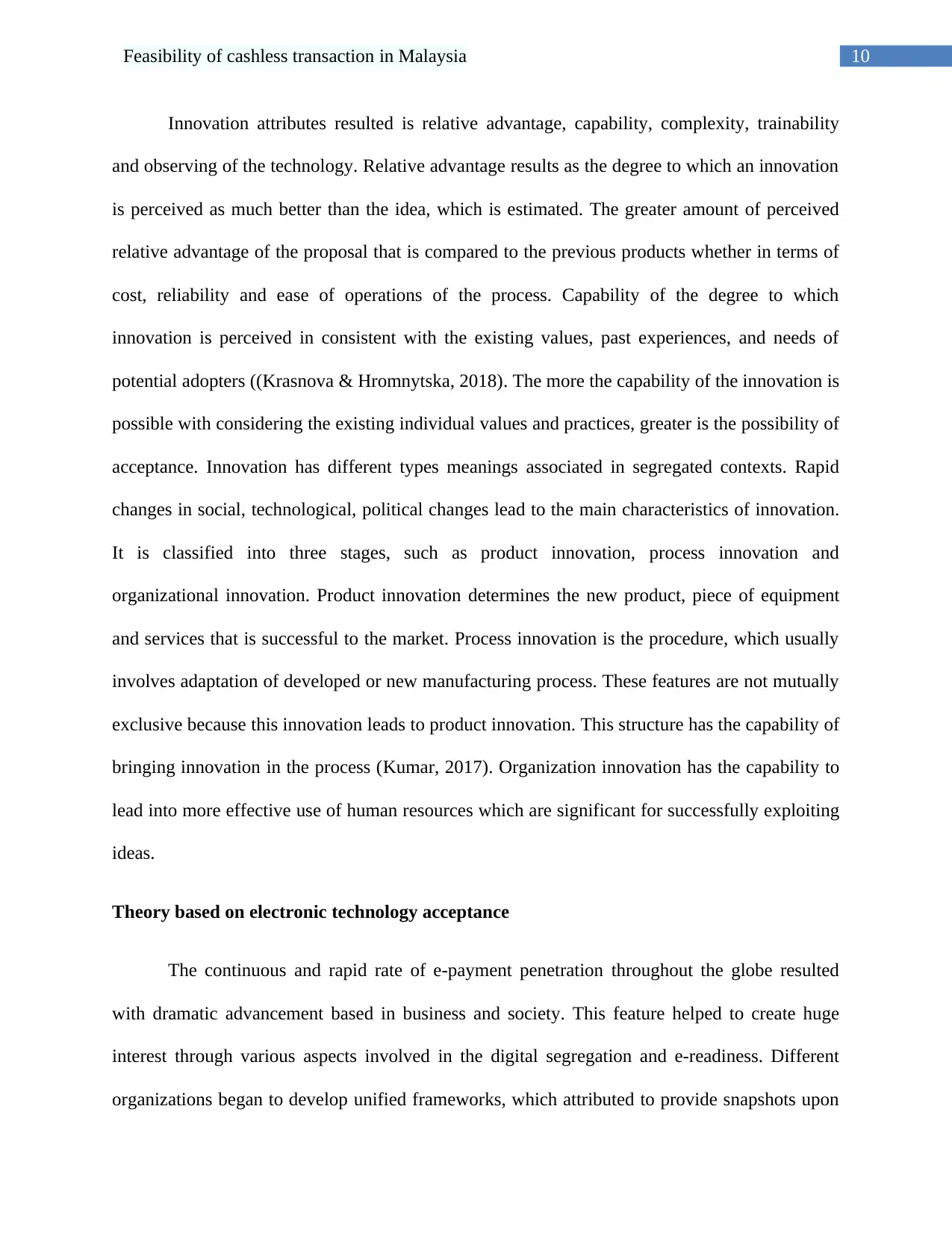
10Feasibility of cashless transaction in Malaysia
Innovation attributes resulted is relative advantage, capability, complexity, trainability
and observing of the technology. Relative advantage results as the degree to which an innovation
is perceived as much better than the idea, which is estimated. The greater amount of perceived
relative advantage of the proposal that is compared to the previous products whether in terms of
cost, reliability and ease of operations of the process. Capability of the degree to which
innovation is perceived in consistent with the existing values, past experiences, and needs of
potential adopters ((Krasnovа & Hromnytska, 2018). The more the capability of the innovation is
possible with considering the existing individual values and practices, greater is the possibility of
acceptance. Innovation has different types meanings associated in segregated contexts. Rapid
changes in social, technological, political changes lead to the main characteristics of innovation.
It is classified into three stages, such as product innovation, process innovation and
organizational innovation. Product innovation determines the new product, piece of equipment
and services that is successful to the market. Process innovation is the procedure, which usually
involves adaptation of developed or new manufacturing process. These features are not mutually
exclusive because this innovation leads to product innovation. This structure has the capability of
bringing innovation in the process (Kumar, 2017). Organization innovation has the capability to
lead into more effective use of human resources which are significant for successfully exploiting
ideas.
Theory based on electronic technology acceptance
The continuous and rapid rate of e-payment penetration throughout the globe resulted
with dramatic advancement based in business and society. This feature helped to create huge
interest through various aspects involved in the digital segregation and e-readiness. Different
organizations began to develop unified frameworks, which attributed to provide snapshots upon
Innovation attributes resulted is relative advantage, capability, complexity, trainability
and observing of the technology. Relative advantage results as the degree to which an innovation
is perceived as much better than the idea, which is estimated. The greater amount of perceived
relative advantage of the proposal that is compared to the previous products whether in terms of
cost, reliability and ease of operations of the process. Capability of the degree to which
innovation is perceived in consistent with the existing values, past experiences, and needs of
potential adopters ((Krasnovа & Hromnytska, 2018). The more the capability of the innovation is
possible with considering the existing individual values and practices, greater is the possibility of
acceptance. Innovation has different types meanings associated in segregated contexts. Rapid
changes in social, technological, political changes lead to the main characteristics of innovation.
It is classified into three stages, such as product innovation, process innovation and
organizational innovation. Product innovation determines the new product, piece of equipment
and services that is successful to the market. Process innovation is the procedure, which usually
involves adaptation of developed or new manufacturing process. These features are not mutually
exclusive because this innovation leads to product innovation. This structure has the capability of
bringing innovation in the process (Kumar, 2017). Organization innovation has the capability to
lead into more effective use of human resources which are significant for successfully exploiting
ideas.
Theory based on electronic technology acceptance
The continuous and rapid rate of e-payment penetration throughout the globe resulted
with dramatic advancement based in business and society. This feature helped to create huge
interest through various aspects involved in the digital segregation and e-readiness. Different
organizations began to develop unified frameworks, which attributed to provide snapshots upon
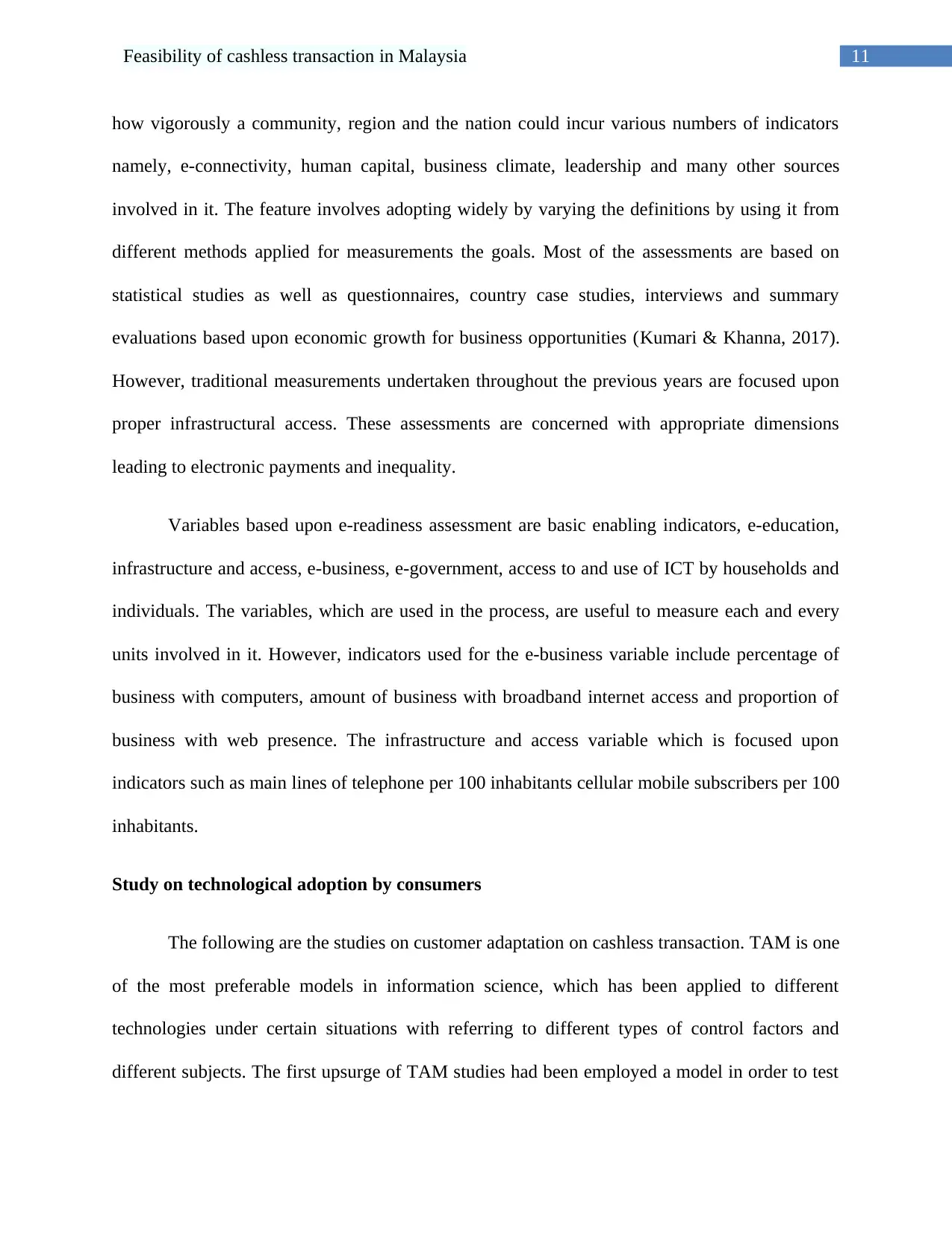
11Feasibility of cashless transaction in Malaysia
how vigorously a community, region and the nation could incur various numbers of indicators
namely, e-connectivity, human capital, business climate, leadership and many other sources
involved in it. The feature involves adopting widely by varying the definitions by using it from
different methods applied for measurements the goals. Most of the assessments are based on
statistical studies as well as questionnaires, country case studies, interviews and summary
evaluations based upon economic growth for business opportunities (Kumari & Khanna, 2017).
However, traditional measurements undertaken throughout the previous years are focused upon
proper infrastructural access. These assessments are concerned with appropriate dimensions
leading to electronic payments and inequality.
Variables based upon e-readiness assessment are basic enabling indicators, e-education,
infrastructure and access, e-business, e-government, access to and use of ICT by households and
individuals. The variables, which are used in the process, are useful to measure each and every
units involved in it. However, indicators used for the e-business variable include percentage of
business with computers, amount of business with broadband internet access and proportion of
business with web presence. The infrastructure and access variable which is focused upon
indicators such as main lines of telephone per 100 inhabitants cellular mobile subscribers per 100
inhabitants.
Study on technological adoption by consumers
The following are the studies on customer adaptation on cashless transaction. TAM is one
of the most preferable models in information science, which has been applied to different
technologies under certain situations with referring to different types of control factors and
different subjects. The first upsurge of TAM studies had been employed a model in order to test
how vigorously a community, region and the nation could incur various numbers of indicators
namely, e-connectivity, human capital, business climate, leadership and many other sources
involved in it. The feature involves adopting widely by varying the definitions by using it from
different methods applied for measurements the goals. Most of the assessments are based on
statistical studies as well as questionnaires, country case studies, interviews and summary
evaluations based upon economic growth for business opportunities (Kumari & Khanna, 2017).
However, traditional measurements undertaken throughout the previous years are focused upon
proper infrastructural access. These assessments are concerned with appropriate dimensions
leading to electronic payments and inequality.
Variables based upon e-readiness assessment are basic enabling indicators, e-education,
infrastructure and access, e-business, e-government, access to and use of ICT by households and
individuals. The variables, which are used in the process, are useful to measure each and every
units involved in it. However, indicators used for the e-business variable include percentage of
business with computers, amount of business with broadband internet access and proportion of
business with web presence. The infrastructure and access variable which is focused upon
indicators such as main lines of telephone per 100 inhabitants cellular mobile subscribers per 100
inhabitants.
Study on technological adoption by consumers
The following are the studies on customer adaptation on cashless transaction. TAM is one
of the most preferable models in information science, which has been applied to different
technologies under certain situations with referring to different types of control factors and
different subjects. The first upsurge of TAM studies had been employed a model in order to test
⊘ This is a preview!⊘
Do you want full access?
Subscribe today to unlock all pages.

Trusted by 1+ million students worldwide
1 out of 61
Related Documents
Your All-in-One AI-Powered Toolkit for Academic Success.
+13062052269
info@desklib.com
Available 24*7 on WhatsApp / Email
![[object Object]](/_next/static/media/star-bottom.7253800d.svg)
Unlock your academic potential
Copyright © 2020–2025 A2Z Services. All Rights Reserved. Developed and managed by ZUCOL.




